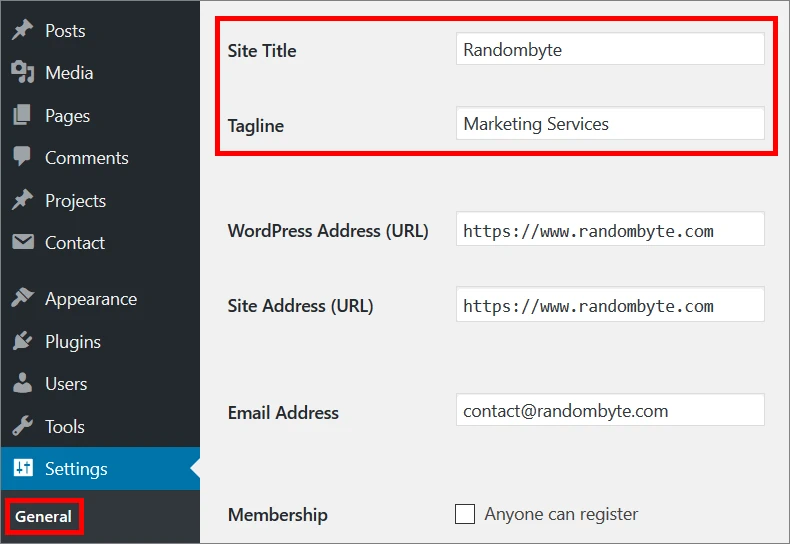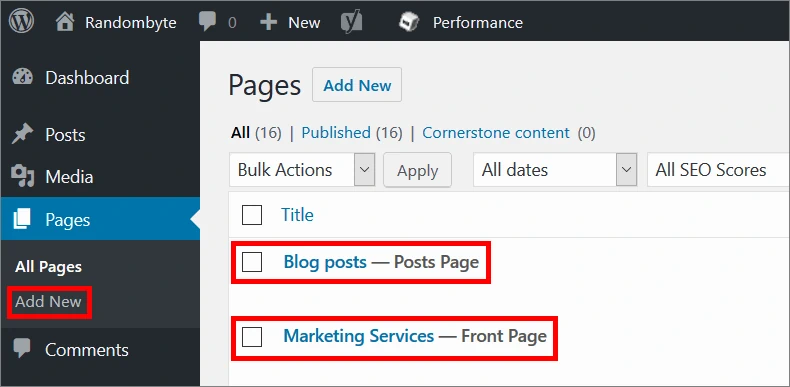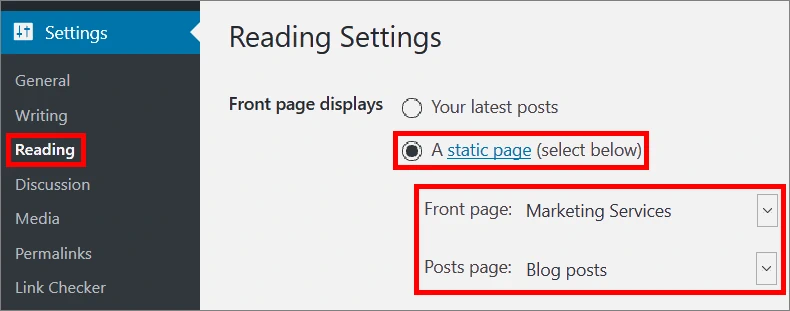So, you want to optimize a new or existing site for SEO purposes, and you wonder if this will make it rank higher in Google’s search results? Here’s a true story.
I decided to kill a page on this site a while ago. Not the entire website, but a specific page that had been ranking organically in Google’s top 5 for years. The page was optimized for a competitive keyword with a monthly search volume of about 1,000 and a $15 cost-per-click (CPC).
That keyword had been sending me qualified SEO leads for years. I can understand why some people would call my action “madness.” I called it an “SEO experiment.”
I decided to tweak the page title for two months. I changed it from the targeted keyword to one that was SEO-related but didn’t have commercial intent.
Aren’t you curious to know what happened? I know I was!

Just by changing the title, my rankings dropped from #5 to #14. Google thought that my page wasn’t relevant for that keyword anymore, even though the actual page content did not change at all.
So yes, even a minor tweak like this can make a website profitable or send it into the web abyss. If your site doesn’t show up at the top of the search results, people won’t see it, so they won’t buy your products or services.
Therefore, it is critical to optimize your website for SEO purposes. Let’s go through the entire process, step by step.
1. Keyword research and analysis
Your first task is to build a list of highly relevant keywords; otherwise, you will waste your time and money trying to convert visitors into customers.
Most people use Google Keyword Planner, so almost everyone targets the same sets of keywords. That’s good news for Google (CPC costs increase), but it prevents us from discovering low-competition keywords that have good commercial value.
Here’s how you can do thorough keyword research using Ahrefs, a powerful SEO tool. If you don’t have an account, you can use their $7 “Standard” trial, and then cancel the account. This can save you a lot of time.
Begin by researching your top 10 competitors’ URLs. Type in your targeted keywords into Google’s search box, and then see which websites show up consistently.
Imagine you want to create a website that offers online marketing services. Use the “SEO company” keyword as a starting point. This is what people from San Jose, California see when they search for “SEO company.”
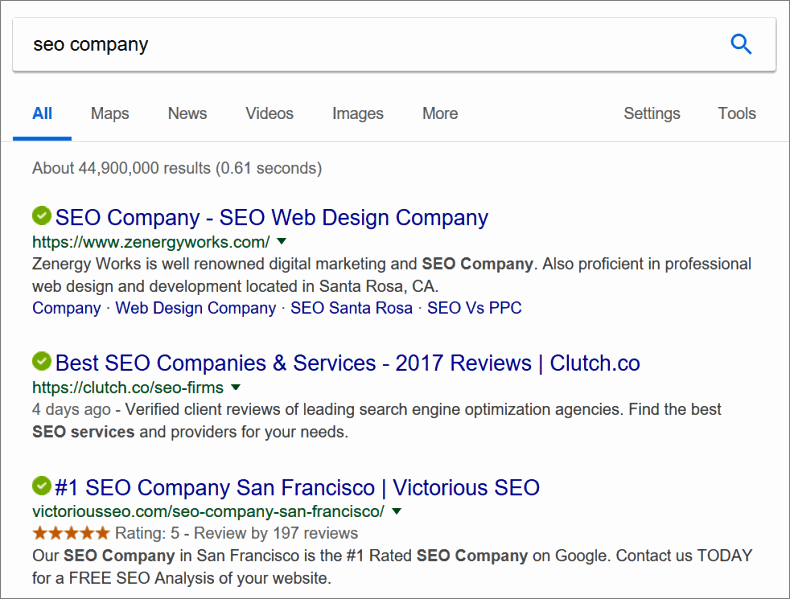
To keep things simple, limit the number of competitors to 3 for this article. Be sure to evaluate the top 10 ranking websites for all your projects, though.
Don’t study business directories, company review sites, etc. Clutch.co in the image above isn’t relevant, for example. Only pick websites that are run by your direct competitors for your analysis.
Input your competitors’ URLs into Ahrefs’ “Site Explorer,” one at a time. Then, click the “Organic keywords” link in the left-side menu.
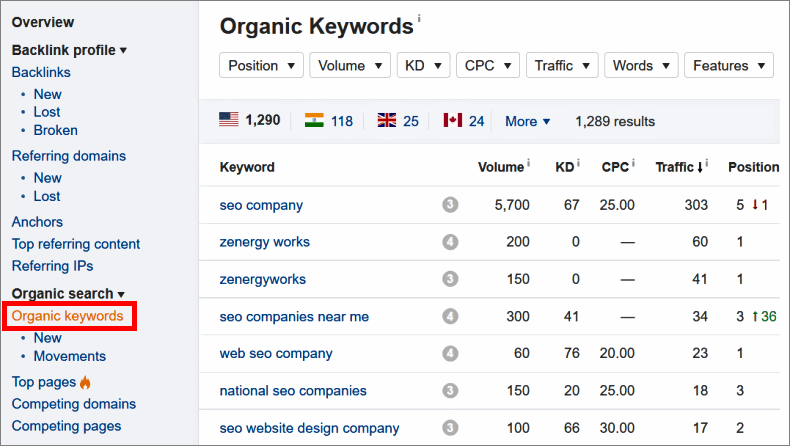
Export the keyword lists for the top 10 sites, and then merge all the keywords into a single Excel spreadsheet.
With my top 3 sites, I obtained a list of 8,000+ keywords. After removing the duplicates, the list was reduced to 4,107 unique keywords.
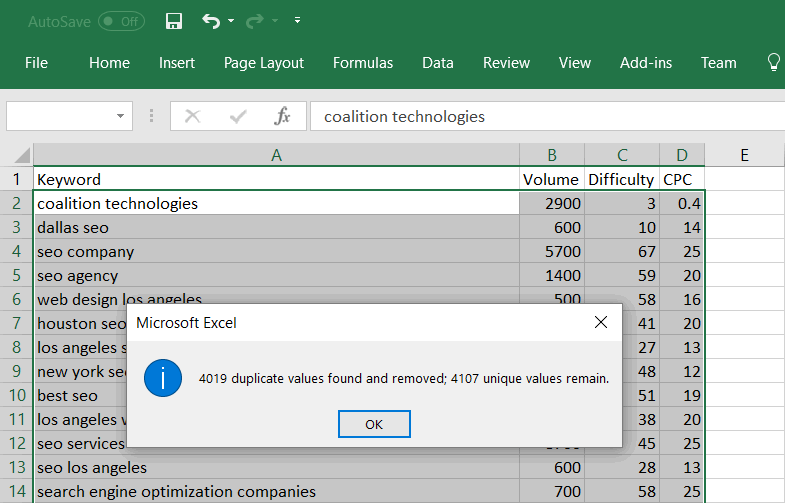
It would take several days to go through the entire list! Fortunately, we can get rid of irrelevant keywords easily by filtering them according to their CPC.
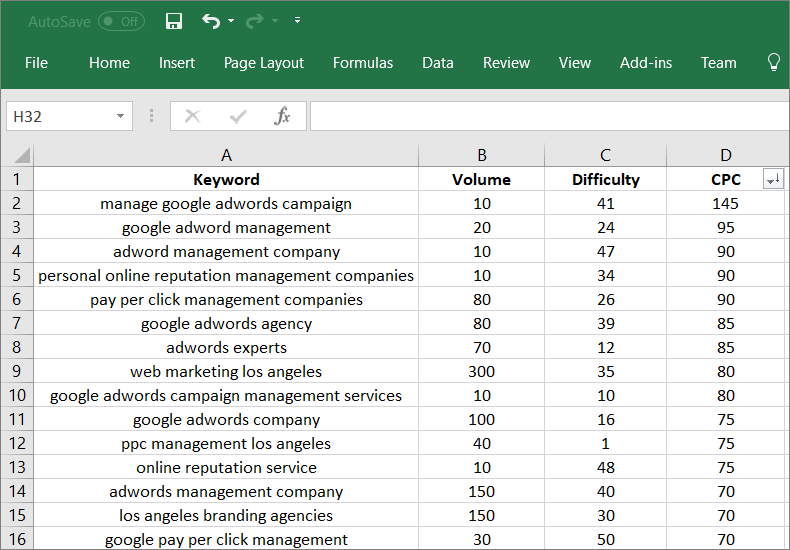
Why sort the keywords this way? Because companies pay a lot of money – up to $145 per click! – to have their ads displayed in Google’s search results whenever people are typing these keywords. Business owners don’t like to waste money, so keywords with high CPC must be very profitable.
My recommendation is to delete all the keywords that have a CPC value of under one dollar. It is true that some industries rely on search volume, rather than traffic quality, so use common sense.
If your filtered list has more than 3,000 keywords, you can also remove the ones that have monthly search volumes below 50. Each industry has its specifics, so feel free to adjust this limit as needed.
Now we have a list of unique keywords with a decent monthly search volume and good commercial value. Companies pay at least a dollar for each visitor that clicks an ad and lands on their websites.
You can also use Google Keyword Planner for your research, but you will miss several profitable keywords. Not to mention if you don’t have an active Google Ads campaign, you will see ranges (rather than actual values) for the monthly search volumes.
2. SEO keyword mapping
Surprisingly, some of the high-CPC keywords on your filtered list will be useless. In fact, the list created for this article includes several keywords I’d never want to rank for.
How is this possible? Google’s algorithm isn’t perfect, so it will make mistakes.
Some sites get hacked, and hackers add their own pages and affiliate links, using the authority of the host website to rank fast for those unwanted keywords.
Additionally, a keyword may be profitable, but you don’t necessarily want to rank for it. This means you need to go through all the keywords on the list, one at a time.
This phase of the process is called “keyword mapping.” We want to reverse engineer the searchers’ intent for each keyword. We need answers to these questions: “What are they searching for?” and “What do they actually want?”
The goal is to create website pages and articles that are optimized for the search queries/keywords that interest our visitors.
Start by creating a copy of your keyword list. You don’t want to destroy the filtered results and then start the entire keyword research process again.
Create a new sheet for each category, pasting each keyword into the appropriate sheet. Let’s map the first ten keywords together!
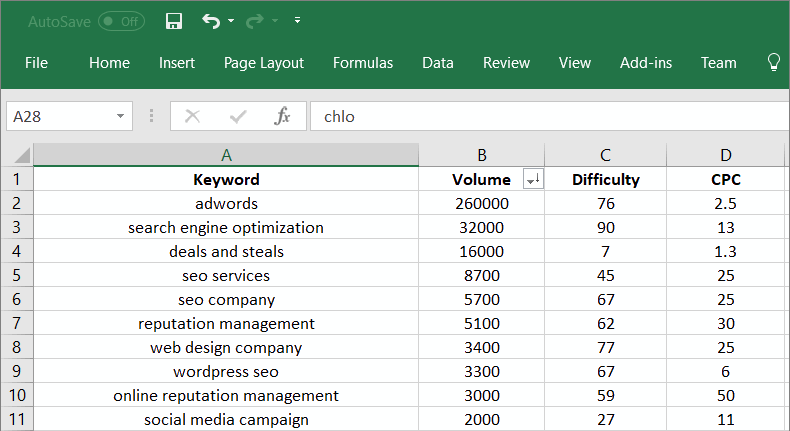
“Adwords” is too vague. Yes, it’s got a huge search volume, but many searches come from people wanting to learn about Google Ads, not necessarily interested in purchasing your PPC Management services.
“Search engine optimization” is better. It’s not laser-targeted, but companies are willing to pay Google $13 for each click. This keyword is profitable, so we will create a sheet for its category.
Name the new sheet “search engine optimization,” and then assign it the “search-engine-optimization” category/sheet. We can change these names later if we discover better ideas.
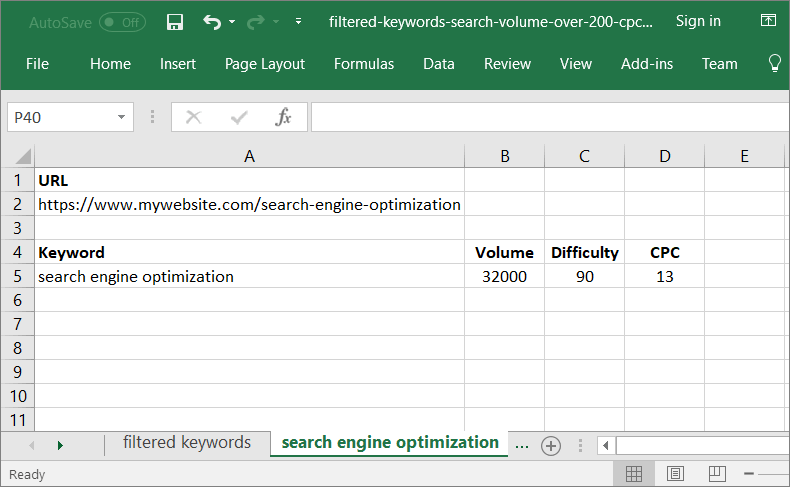
“Deals and steals” is irrelevant, so we will ignore it.
“SEO services” and “SEO company” belong to the “search engine optimization” category, so we will add them to the same sheet.
“Reputation management” needs its own category, so we will create a new sheet for it.
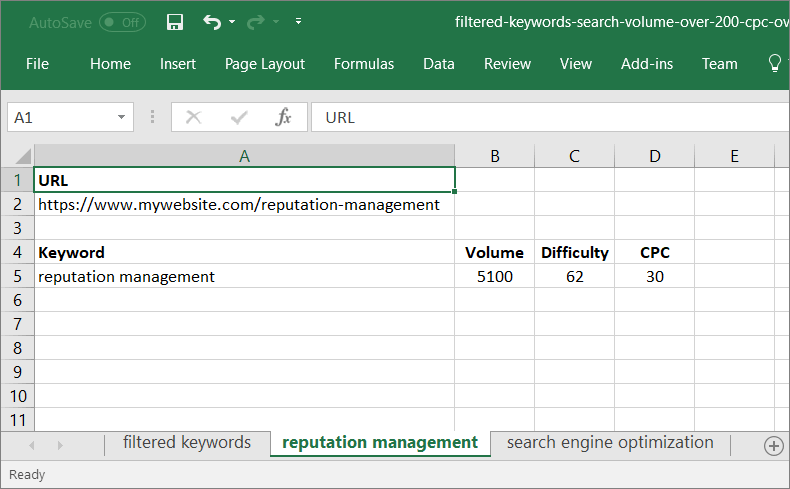
“Web design company” falls into a new category, so we’ll create a new sheet for it as well.
“WordPress SEO” gets its own category and sheet.
“Online reputation management” will be added to the “reputation management” sheet.
“Social media campaign” will be added to a new “social media” sheet.
Repeat the process until you go through all the keywords in the filtered list. Here are the categories that resulted after going through 300+ keywords:
- Home page (“online marketing” keywords)
- Search engine optimization
- Pay-per-click
- Email marketing
- E-commerce SEO
- Content creation
- Mobile advertising
- Social media campaigns
- Web design
- Reputation management
- WordPress SEO
- Blog posts
Here’s the content of the “search engine optimization” sheet.

The “Blog posts” sheet includes many useful blog ideas: “what is search engine optimization”, “how to switch to https”, “what makes a good website”, “how to manage your online reputation”, and so on. If you have a big keyword list, you will get enough blog post ideas to create a content roadmap that can last for years.
3. SEO-based competitor research
You may have noticed that I ignored SEO competition (“Difficulty”) until now. Here’s why: I may not be able to rank on Google’s first page for a highly difficult keyword, but I will rank for several related, long-tail keywords, which can bring in an equivalent amount of high-quality traffic.
There are over 62,000 monthly searches (ms) for all the SEO-related keywords in the sheet above. However, let’s assume that you will only be able to get first-page rankings for a few keywords, which have less than 1,000 ms.
If you manage to get the #1 spot for a particular keyword, your website will receive 20-40% of its associated monthly traffic. Here’s a graph that shows typical Google click-through rates.

Let’s assume you have gotten the top spot for “search engine optimization companies.” It’s got 700 monthly searches, and you are getting about 30% of the visitors – that would be 210 people per month.
If your website’s conversion rate is 2%, you will get 210 * 0.02 = 4 new clients per month. If each client pays you $1,000 and your net earnings per client are $600, you will have a monthly net income of 600 x 4 = 2,400 from that keyword alone.
This example isn’t 100% accurate, but it can quickly show you if an online-based business has the potential to be profitable or not. It helps you validate a potential business idea fast, without spending much money.
Since your website has several pages and has the potential to rank well for several keywords, its earning potential is much larger.
People working in competitive industries should study the top 10 competitors’ SEO metrics before attacking their keywords. Sometimes the search volume may be too small, and you may not be able to outrank your competitors.
4. Choose a good domain name
You have discovered many great keywords and mapped them. You have analyzed your top 10 competitors, keeping the keywords you can rank for. It’s time to purchase the best domain name.
Start this phase of the process by thinking about your target market. Who are your ideal customers? Will your domain name idea be appealing to them? Is it short, punchy, and easy to remember?
Always go for a .com domain name. Don’t pick a .online, .rock, etc. domain. They may look cool to some people, but you want to buy a domain that will rank high in Google.
Use one of these online services to discover great domain names:
a) Instant Domain Search if you already know what you want. Go to that website, and type in the desired domain name; you will see its availability in real time. Make minor changes (use synonyms, plurals, etc.) until you discover the best .com domain.

Domains with a green bar below their names are available, so you can purchase them. Move the mouse over the three green dots to access several useful options. You can check if the corresponding user accounts are available at the top social media sites, for example.
b) Lean Domain Search is a better option if you are looking for ideas. The website will add several terms at the beginning and end of your targeted keyword, showing you what .com domain names are available.

You can sort the domains according to their popularity, length, or alphabetically. The site will also tell you if the desired Twitter/X username is available.
Always pick a domain name that allows your business to grow. Don’t choose “MarketingConsultantLakewood.com” if you plan to offer SEO services nationwide in the future.
5. Choose a good website hosting company
This section is short because I can’t recommend a specific hosting company. Amazon Web Services (AWS) has a more complex setup, but it works great for me. I have used AWS to build several sites that load in under a second – see for yourself.
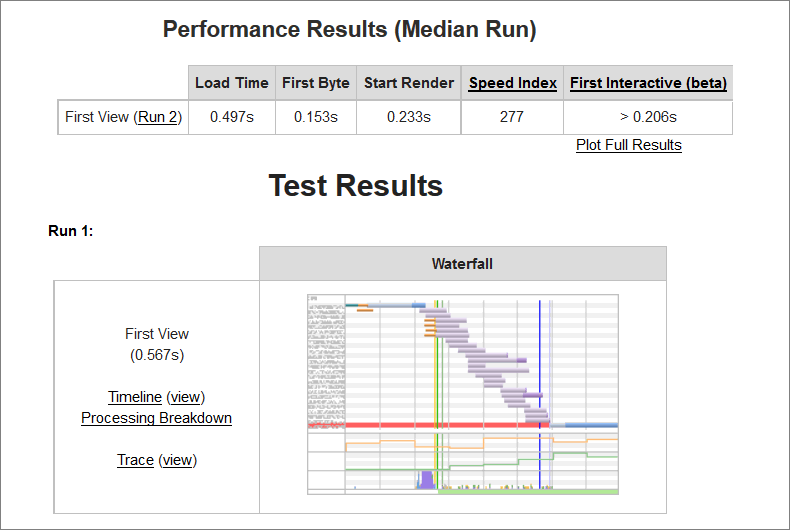
To verify the quality of your hosting account, install WordPress, and then check its loading speed using any website speed testing service. If loading time exceeds two seconds, ask for a refund, and then move on to the next hosting provider.
Prepare to spend some money for a high-quality web hosting account. Prices can range from $20 to $200 per month, depending on your requirements (loading speed, estimated number of monthly visitors, additional services, etc.).
6. Install and configure WordPress
Most providers use cPanel, a hosting control panel that makes installing WordPress a breeze. Simply log into cPanel, and then click the “QuickInstall” icon.
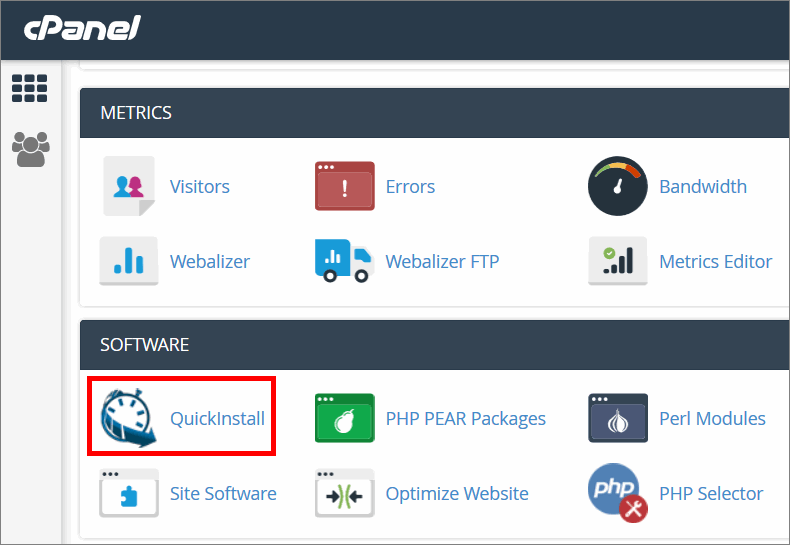
Pick “WordPress” from the list, and fill in the required details. Then, press the “Install WordPress” button.
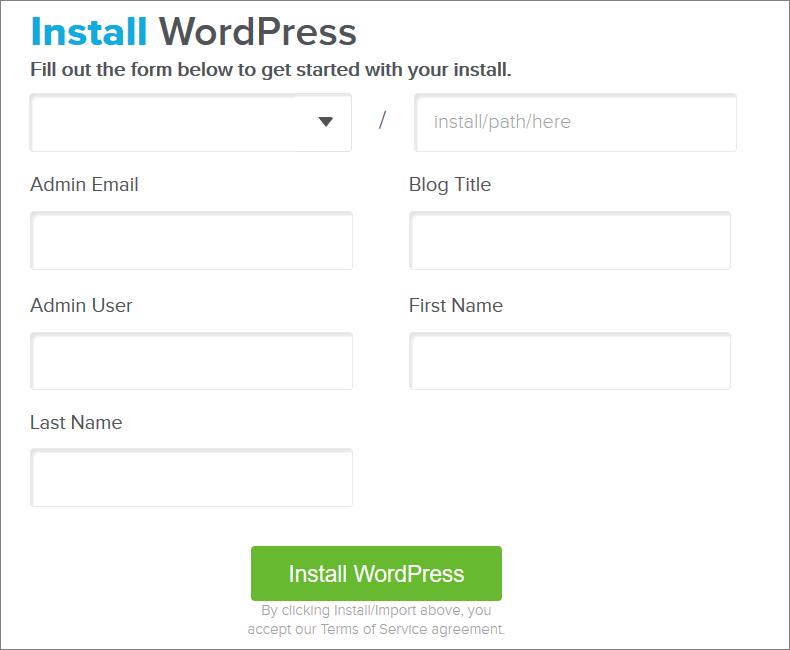
Don’t ever use “admin” for the “Admin User” name. This is the default name for most WordPress installations, so you will make it easy for hackers to get into your site. Always use admin names such as “xy32tyM47.”
Once WordPress is installed, it’s time to customize it. Log in using the provided username and password, and then make these changes:
a) Choose “Users” -> “Your Profile.” Set a user-friendly “Nickname,” and have it displayed publicly, instead of using your real “Username.”
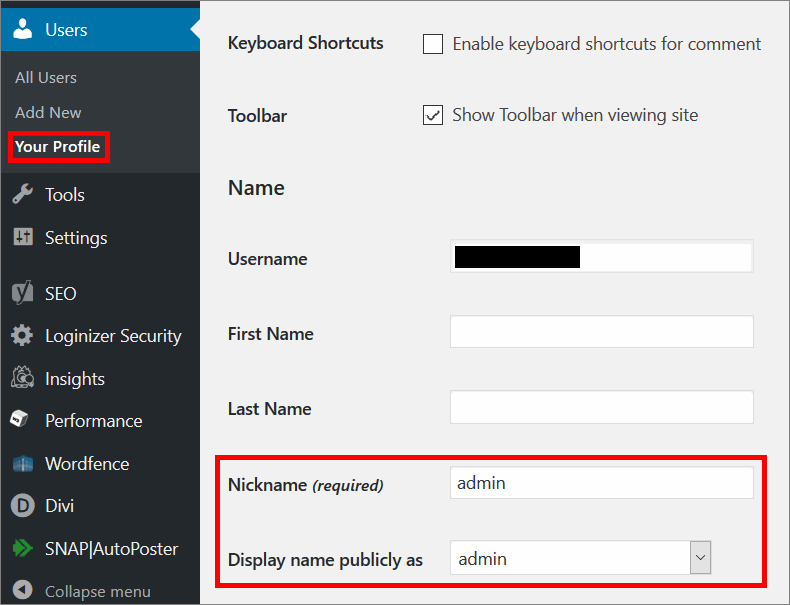
b) Pick “Settings” -> “General,” and set the “Site title” and “Tagline.”
Make sure to use the best keyword in the “Home Page” category for your website tagline. This is a strong ranking factor.
c) Create two pages: one with the same name as your tagline (main keyword), which will be used for the home page, and one for your blog posts.
d) Choose “Settings” -> “Reading,” and select the option to display a static page for your Home Page. Pick the proper pages for “Front page” and “Posts page.”
e) Select “Settings” -> “Permalinks,” and choose the “Post name” option. This way, your page and article titles will be included in the website URLs by default.
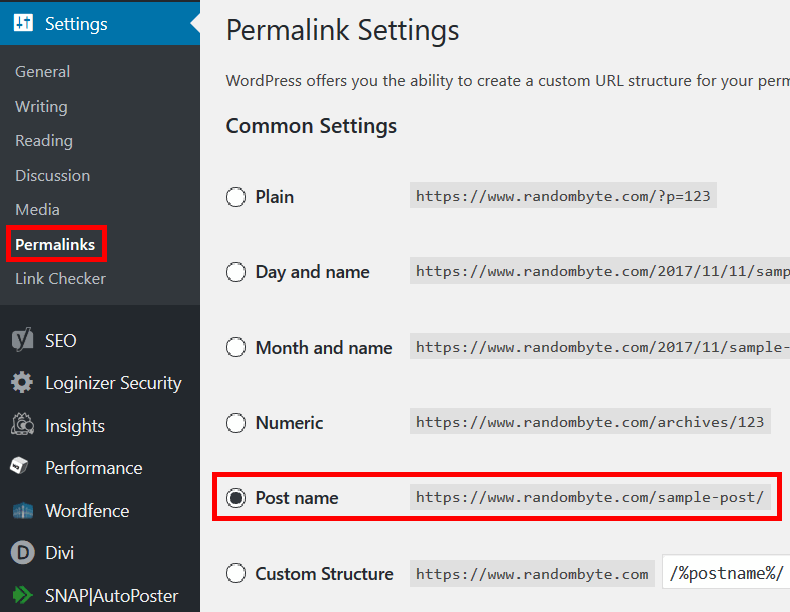
Keywords in URLs are another important ranking factor. Since your titles must include the targeted keywords, the resulting URLs will include them as well, giving your website an SEO boost.
7. Install a good WordPress theme
It is time to install a niche-related WordPress theme, which will make your website look professional. There are three possible options.
a) Use a free WordPress theme. Choose “Appearance” -> “Themes” -> “Add New Theme,” and you will see a huge list of free themes.
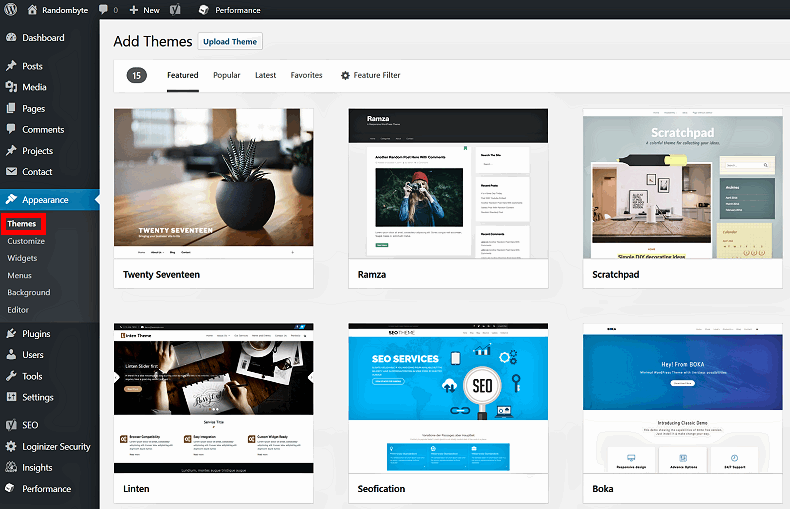
Use the search box in the upper right corner to find themes created for a specific industry. However, you shouldn’t use free themes for projects you care about. You want to use a theme that won’t be discontinued in a year and comes with tech support.
b) A much better option is to purchase a WordPress theme. Websites like Theme Forest offer tens of thousands of high-quality themes, and their prices range from $30 to $60. Most of these themes include detailed manuals and tutorials, and you can ask their developers any questions that you may have in case you get stuck.
c) The best solution is to work with a web designer and get a custom, high-quality WordPress theme that matches all your expectations.
No matter what theme you use, don’t necessarily go for one that claims to be “SEO optimized.” Very few people understand the inner aspects of search engine optimization, and some SEO plugins do a much better job.
8. Use the best free SEO plugins for WordPress
I install two SEO plugins every time I set up a new site for one of my clients. Choose “Plugins” -> “Add new” in WordPress’ dashboard to find and install them.
a) Yoast SEO
This is by far the best SEO plugin! Install it, and a new section will appear below each post or page.
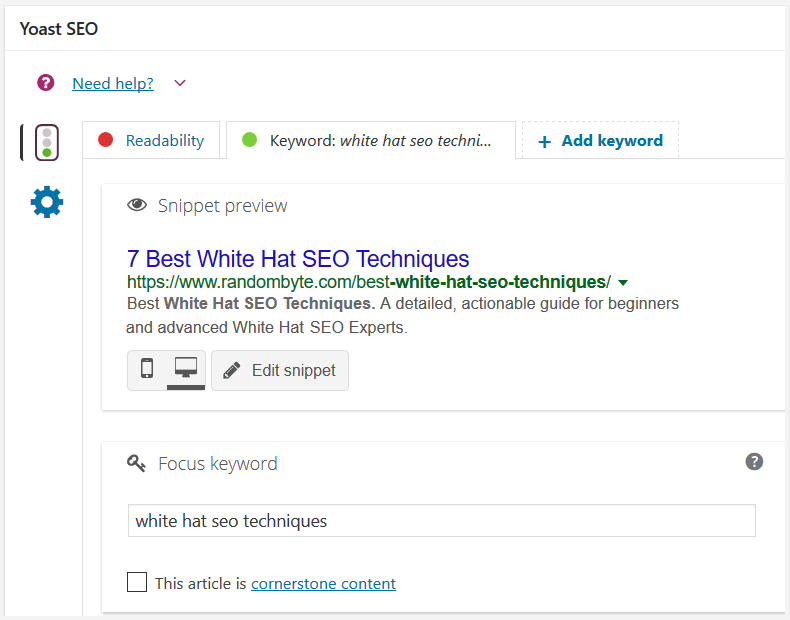
Click the “Edit snippet” button to access the plugin’s key SEO options.
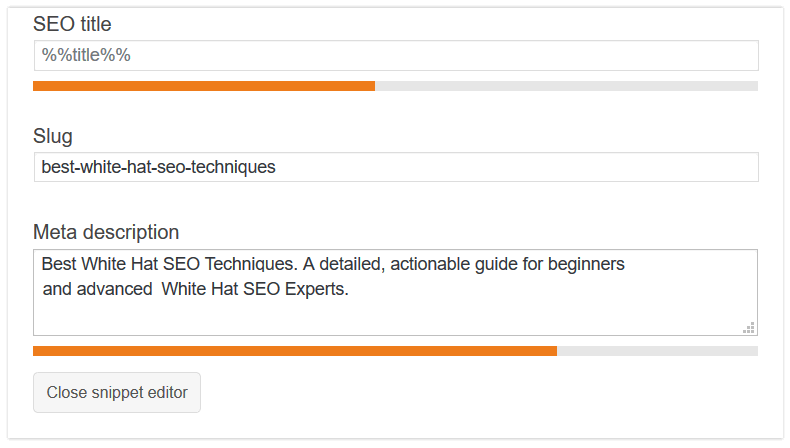
– “SEO title” is the title of your page or blog post. You already know that “keyword in title” is a powerful ranking factor, so be sure to include your targeted keyword here.
– “Slug” sets the URL of your blog post or page. In my case, the “best-white-hat-seo-techniques” slug will create the https://randombyte.com/best-white-hat-seo-techniques/ URL. Be sure to include the targeted keyword here as well.
– “Meta description” is what Google will (hopefully) pick and add below your page title in its search results. Include your keyword as close to its beginning as possible. Also, use this opportunity to entice people to click through to your article.
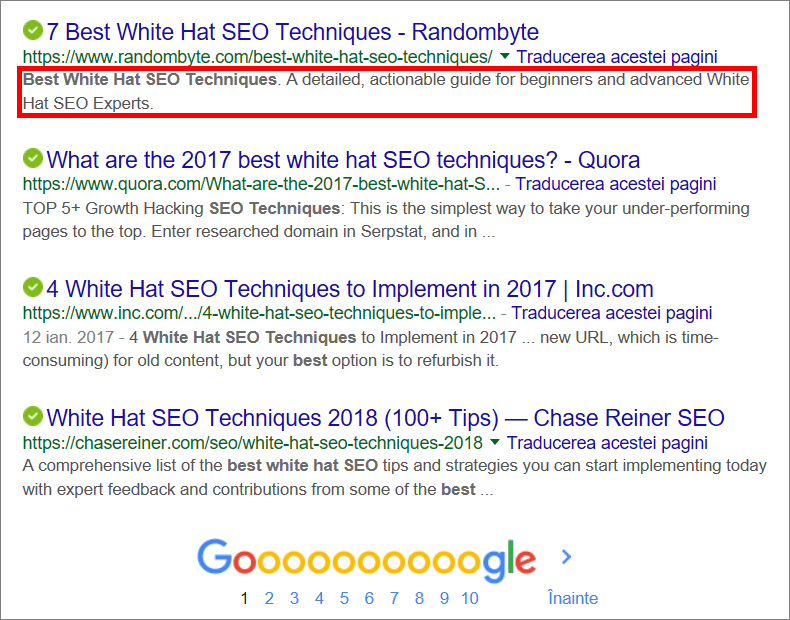
Sometimes, Google will pick a few random words or phrases from the page instead of using your SEO-optimized description. If this happens, try to rewrite the description. It’s not guaranteed to fix the problem because Google sets the rules. Still, it is always a good idea to optimize the meta description tag.
– “Focus keyword” is the keyword you want to rank for with that blog post or page.
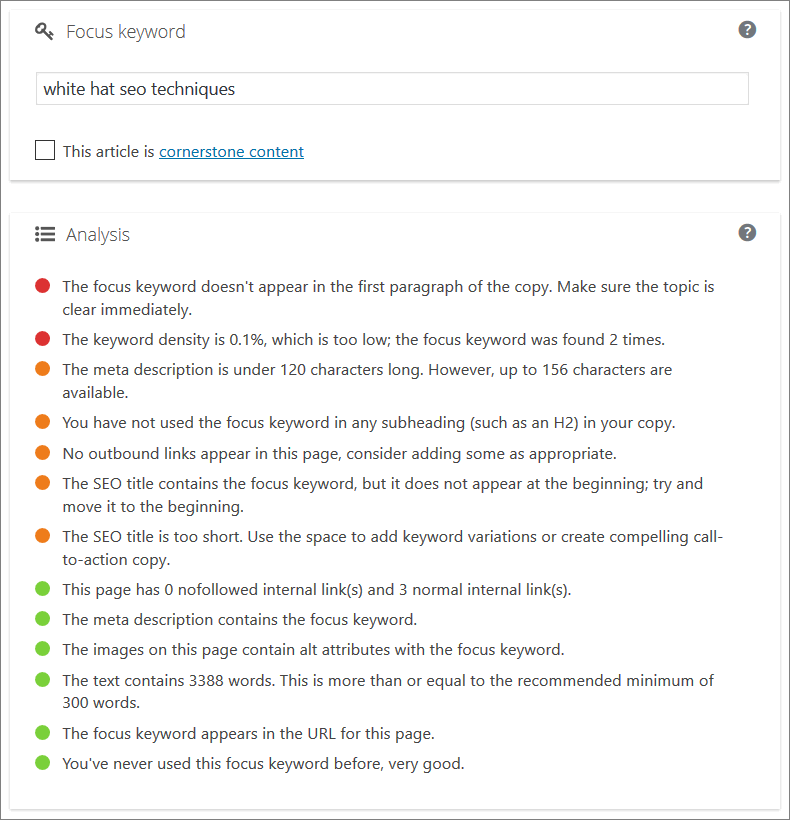
The plugin will highlight several factors that have the potential to help your content rank higher: keyword density, meta description length, number of inbound links, etc.
Don’t butcher your content trying to get all the items green. Google is much smarter than that.
b) Google Analytics for WordPress. This plugin will help you track the number of website visitors. Here are the plugin settings I use.
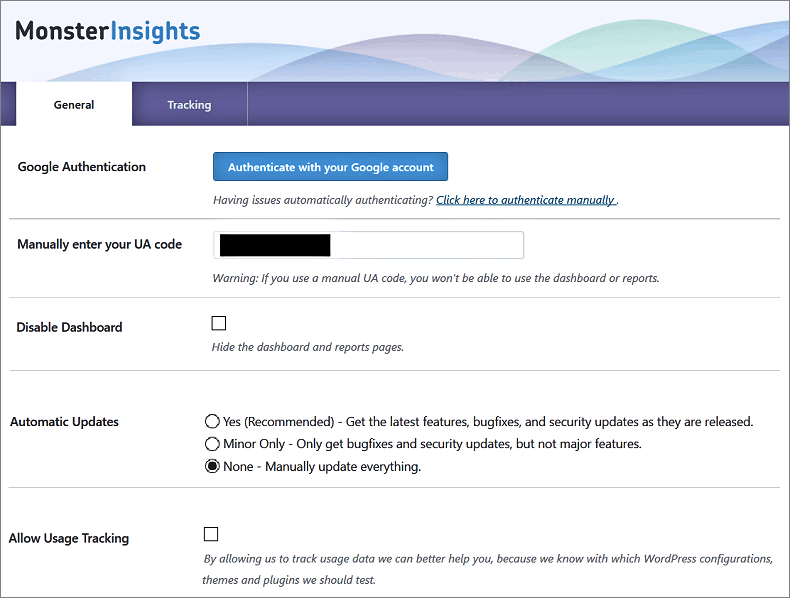
Get the “UA code” from your Google Analytics account. To test if visitor tracking works, go to Google Analytics -> REAL-TIME -> Overview. Open a “New incognito window” (Google Chrome), “New InPrivate window” (Microsoft Edge), or “New Private Window” (Mozilla Firefox), and open your website URL. You should see a new visitor on your site after a few seconds.
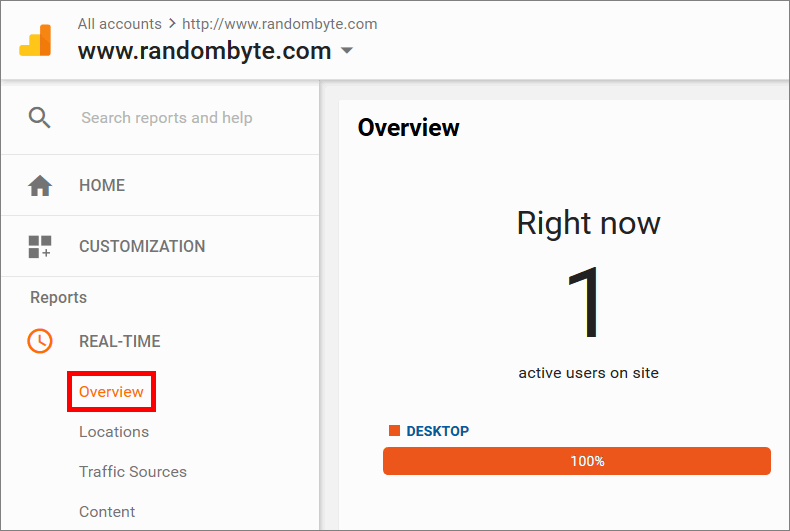
Congratulations! You have built an SEO-optimized website that is ready for content.
9. Write SEO-friendly content
Posts and pages are very similar from an SEO perspective. Use pages for resources that should be featured permanently in the website menu, and posts for resources discussing a specific category topic.
Use the keyword map to create the needed pages and blog posts. Here are the key guidelines that must be followed:
a) Include the targeted keyword in the page/article title and URL. Shorten the URL if needed, but keep the entire keyword.
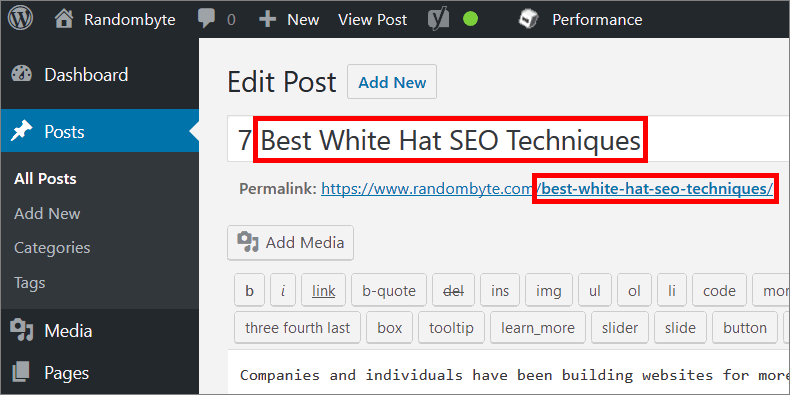
b) Similar keywords should be included in the same page or post. Don’t create separate pages for similar keywords like:
“search engine optimization company”
“SEO marketing companies”
“SEO firm”
Group similar keywords and pick one as your main target. Then, use the other keywords in the content as headings, etc., whenever it is possible to do naturally. If a keyword can’t fit naturally, ignore it.
c) Use “People also ask” and “Searches related to” sections to find relevant content ideas.
Search for the targeted keyword in Google, and look at the “People also ask” section. You will see many relevant questions, actually typed by people into Google’s search box. Each time you click one of the questions, the list will grow.
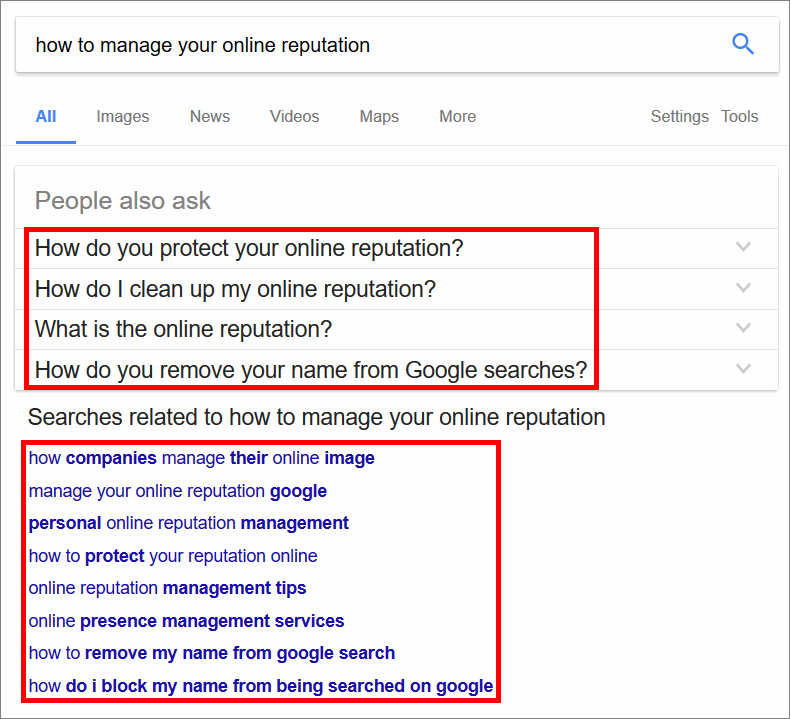
The “searches related to” section can be found at the bottom of Google’s search results pages. Go through several pages of search results, and you may end up with a list of dozens of great ideas for your article sections.
Let’s use the “How to manage your online reputation” article idea as an example. I can easily write a detailed article by answering some of the “People also ask” questions:
What does online reputation mean?
How do you protect your online reputation?
How do I clean up my online reputation?
What is a reputation management system?
What does an online reputation manager do?
What is corporate reputation management?
Some of these suggestions can also be used for article headings, of course.
d) Create the article outlines in one go, and save them as drafts. They won’t be published, so nobody will see them until you write the actual content and hit the “Publish” button.
e) It’s time to start writing! Create amazing, comprehensive content packed with useful, actionable information. Ensure your content includes at least some related keywords from your list and a few keywords suggested by Google. However, this shouldn’t be your primary goal.
Write your content using short paragraphs, and separate them using white space, images, etc. Use stats, relevant graphics, videos, and so on whenever they add value to your article. Each word/image/video should have a clear purpose. Don’t just add a stock photo to your articles; it is much better to create and use a graph based on fresh industry data.
Write articles that answer your visitors’ questions fully, explaining everything there is to know about the targeted topic. If you do proper research, your content pieces will easily exceed 1,000 words. Don’t focus on content length, though. Keep your content 100% meaty.
Post links to related articles at the end of each content piece. You want to keep the readers on your site because Google rewards longer dwell times with higher rankings.
I use a “Further reading” section at the end of my articles, suggesting several related, useful articles.
As you now know, building a website that’s fully optimized for SEO purposes from scratch isn’t that complicated. It takes time, of course, but the results are well worth the effort.
Further reading:


